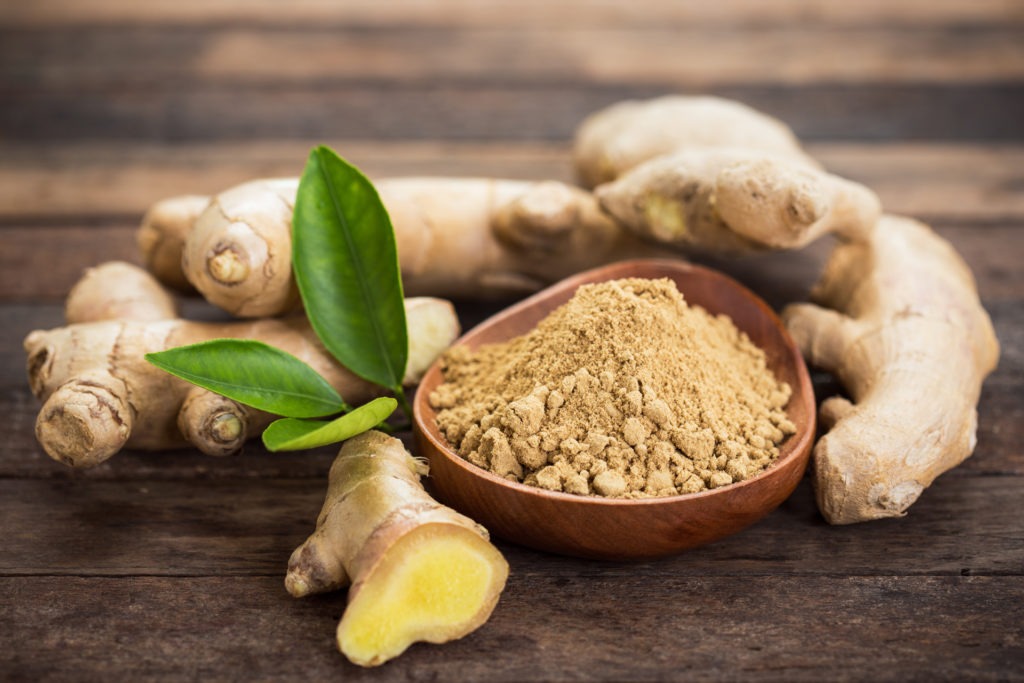Fighting Inflammation with Ginger

You love adding ginger to your meats or veggies but did you know that your favorite spice is also a natural “pain killer?”
The spice ginger is the natural root of the ginger plant, known botanically as Zingiber officinale, used in many countries as a spice and condiment to add flavor to food. What most people may not know is that Ginger has a very potent anti-inflammatory effect which has been shown to reduce muscle pain after intense physical activity.
During the past 40 years, many studies have provided scientific support for the long-held belief that ginger contains potent anti-inflammatory properties. The original discovery of ginger’s inhibitory effects on prostaglandin biosynthesis in the early 1970s has been repeatedly confirmed. That’s exactly why you’ll find it as a key ingredient in our anti-inflammatory and joint support supplement, Joint Edge Rx, and our post workout supplement Post Edge.
Ginger suppresses prostaglandin synthesis through inhibition of cyclooxygenase-1, cyclooxygenase-2 and 5-lipoxygenase. A University of Miami study compared the effects of ginger extract to placebo in 247 patients with osteoarthritis (OA) of the knee. The ginger reduced pain and stiffness in knee joints by 40 percent over the placebo. Researchers at the University of Georgia in Athens and Georgia State College & University in Milledgeville reported in the Journal of Pain that a few tablespoons of grated ginger can help ease muscle pain caused by exercise.
If the anti-inflammatory properties of ginger mentioned above aren’t enough, ginger also has insulinoptropic properties through the 5-HT3 receptor channel. Activating this receptor increases plasma insulin secretion up to 10%, working synergistically with LionEdge’s Insulin Activation Anabolic Matrix in Post Edge.
Ginger has staring potential for helping treat a number of ailments including degenerative disorders (osteoarthritis and rheumatism), digestive health (indigestion, nausea, hyperemesis, constipation) and also cardiovascular disorders (hypertension and hyperlipidemia) through its anti-inflammatory properties.
Ginger is also currently being studied for anti-oxidative properties for controlling the process of aging. More research on this is under way. Don’t forget, next time you’re at a sushi restaurant, ask for extra ginger. It’s what the doctor ordered!
References
- Phan PV, Sohrabi A, Polotsky A, Hungerford DS, Lindmark L, Frondoza CG. Ginger extract components suppress induction of chemokine expression in human synoviocytes. J Altern Complement Med. 2005 Feb;11(1):149-54. 2005.
- Jagetia GC, Baliga MS, Venkatesh P, Ulloor JN. Influence of ginger rhizome (Zingiber officinale Rosc) on survival, glutathione and lipid peroxidation in mice after whole-body exposure to gamma radiation. Radiat Res. 2003 Nov;160(5):584-92. 2003.
- Kiuchi F, et al. Inhibition of prostaglandin and leukotriene biosynthesis by gingerols and diarylheptanoids. Chem Pharm Bull 40 (1992):387-91. 1992.
- Srivastava KC, Mustafa T. Ginger (Zingiber officinale) in rheumatism and musculoskeletal disorders. Med Hypothesis 39(1992):342-8. 1992.
- Wigler I, Grotto I, Caspi D, Yaron M. The effects of Zintona EC (a ginger extract) on symptomatic gonarthritis. Osteoarthritis Cartilage. 2003 Nov;11(11):783-9. 2003.
- Terry R, Posadzki P, Watson LK, Ernst E. The use of ginger for the treatment of pain: a systematic review of clinical trials. Pain Med. 2011 Dec;12(12):1808-18.
- 7. Nammi S, Sreemantula S, Roufogalis BD. Protective effects of ethanolic extract of Zingiber officinale rhizome on the development of metabolic syndrome in high-fat diet-fed rats. Basic Clin Pharmacol Toxicol. 2009;104:366–73.
- Heimes K, Feistel B, Verspohl EJ. Impact of the 5-HT receptor channel system for insulin secretion and interaction of ginger extracts. Eur J Pharmacol. 2009;624:58–65.
- Dugasani S, Pichika MR, Nadarajah VD, Balijepalli MK, Tandra S, Korlakunta JN. Comparative antioxidant and anti-inflammatory effects of [6]-gingerol, [8]-gingerol, [10]-gingerol and [6]-shogaol. J Ethnopharmacol. 2010;127:515–20.
- Ohshima H, Tatemicho M, Sawa T. Chemical basis of inflammation-induced carcinogenesis. Arch Biochem Biophys. 2003;417:3–11.
- Ramaa CS, Shirode AR, Mundada AS, Kadam VJ. Nutraceuticals an emerging era in the treatment and prevention of cardiovascular diseases. Curr Pharm Biotechnol. 2006;7:15–23.
